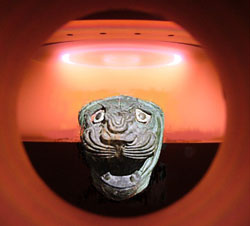Eco-friendly conservation of archaeological treasures
The EFESTUS project adopted the plasma enhanced chemical vapour deposition (PECVD) technique for producing new corrosion resistant organosilicon thin films with protective barrier effects against aggressive agents on bronze archaeological artefacts. This eco-friendly, reliable and effective method was implemented in a home-made reactor. It started from such organosilicon precursors, as hexamethyldisiloxane (HMDSO), tetraethoxysilane (TEOS), tetramethoxysilane (TMOS), and with different oxygen-argon mixtures and different input power values. This took place in the Department of Materials Science and Chemical Engineering of the Politechnic of Torino. The innovative coatings similar to SiO2, were tested and optimised on copper-based reference alloys produced by ISMN-CNR, the Institute for the Study of Nanostructured Materials in Montelibretti-Rome. This was done in the conditions in which they were received and aged in different soils. The reference alloys possessing micro-chemical and micro-structural characteristics similar to the ancient alloys, allow a reliable optimisation of the PECVD coatings proposed for the later stage of restoration and protection of bronze archaeological artefacts. Extensive testing of the used parameters resulted in the optimisation of the PECVD treatment technique. Moreover, the plasma phase, the characteristics of the obtained deposits and all possible operative scenarios were extensively explored. In summary the corrosion protection properties similar to SiO2 thin films are strongly affected by the variation of the plasma process parameters. There is a marked increase in the protective effectiveness of the coatings obtained with the increase of the discharge input power. Plasma pre-treatment processes play an important role in determining the inhibiting properties of the deposited film. The pre-treatment removes the surface contamination, thereby reducing the defectiveness degree of the coating and enhancing its adhesion to the substrate. By performing the deposition process in oxygen-rich plasma, a further increase of the protective properties of the layers is achieved. The versatility of the PECVD may be exploited in numerous coatings' applications with various substrates ranging from metals and paper to textiles and polymers. This is due to the low pressure and low temperature operative conditions employed. The analysis of the environmental impact justifies the great interest of performing PECVD treatments on metallic substrates also from an industrial point of view. For further info, click at the project site: http://www.efestus.just.edu.jo/index.jsp



